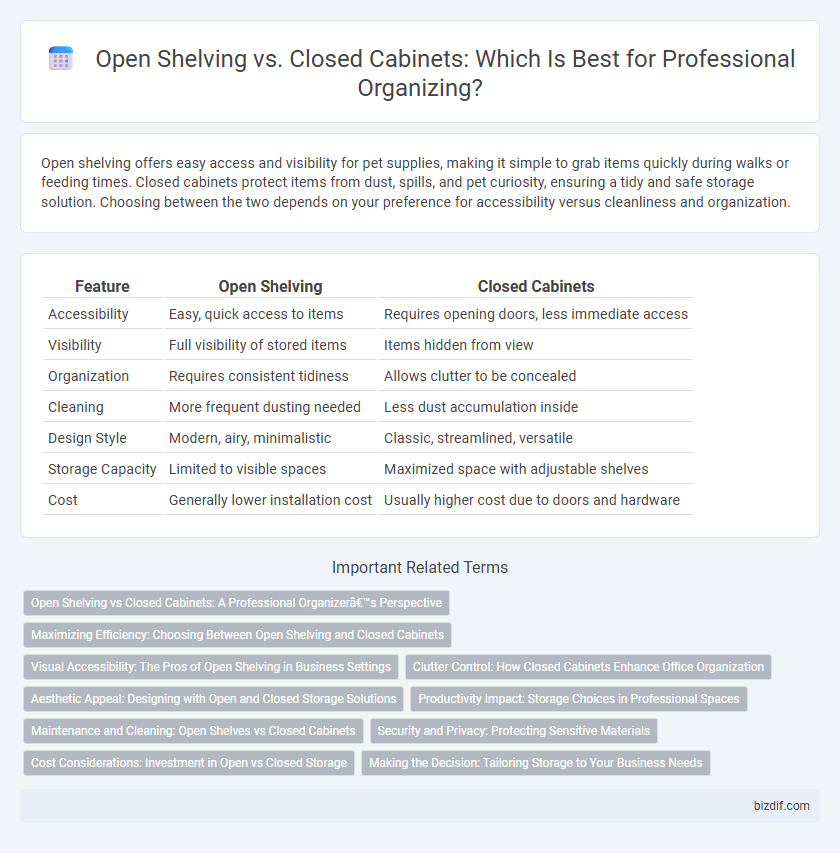Open shelving offers easy access and visibility for pet supplies, making it simple to grab items quickly during walks or feeding times. Closed cabinets protect items from dust, spills, and pet curiosity, ensuring a tidy and safe storage solution. Choosing between the two depends on your preference for accessibility versus cleanliness and organization.
Table of Comparison
| Feature | Open Shelving | Closed Cabinets |
|---|---|---|
| Accessibility | Easy, quick access to items | Requires opening doors, less immediate access |
| Visibility | Full visibility of stored items | Items hidden from view |
| Organization | Requires consistent tidiness | Allows clutter to be concealed |
| Cleaning | More frequent dusting needed | Less dust accumulation inside |
| Design Style | Modern, airy, minimalistic | Classic, streamlined, versatile |
| Storage Capacity | Limited to visible spaces | Maximized space with adjustable shelves |
| Cost | Generally lower installation cost | Usually higher cost due to doors and hardware |
Open Shelving vs Closed Cabinets: A Professional Organizer’s Perspective
Open shelving offers immediate visibility and accessibility, enhancing ease of use and encouraging maintenance of order, which professional organizers often recommend for frequently used items. Closed cabinets provide a clean, clutter-free appearance by concealing contents, ideal for creating a streamlined look and protecting possessions from dust and damage. Choosing between open shelving and closed cabinets depends on the client's lifestyle, storage needs, and desired aesthetic, with many organizers suggesting a balanced combination for optimal functionality and design.
Maximizing Efficiency: Choosing Between Open Shelving and Closed Cabinets
Open shelving maximizes efficiency by providing quick, visual access to frequently used items, reducing time spent searching and encouraging organized display. Closed cabinets optimize storage by concealing clutter and protecting contents from dust, ideal for bulkier or less attractive items. Choosing between open shelving and closed cabinets depends on balancing accessibility needs with aesthetic preferences and the type of items stored.
Visual Accessibility: The Pros of Open Shelving in Business Settings
Open shelving enhances visual accessibility by allowing quick identification and retrieval of items, reducing time spent searching for supplies in business environments. This organization method promotes better inventory management as employees can easily monitor stock levels and reorder materials promptly. Open shelving also fosters a more transparent and efficient workspace, improving workflow and operational productivity.
Clutter Control: How Closed Cabinets Enhance Office Organization
Closed cabinets provide superior clutter control by concealing office supplies and documents, creating a cleaner, more organized workspace. Unlike open shelving that exposes items to dust and visual distraction, closed cabinets help maintain a tidy environment that boosts productivity and reduces stress. Their ability to store items out of sight supports efficient organization and a professional office appearance.
Aesthetic Appeal: Designing with Open and Closed Storage Solutions
Open shelving enhances aesthetic appeal by showcasing curated items, creating a visually dynamic and accessible display that highlights personal style. Closed cabinets offer a sleek, streamlined look by concealing clutter and providing a clean, minimalist surface that complements modern and traditional interiors. Combining both storage solutions allows for a balanced design, blending practicality with decorative elements to achieve an organized and visually appealing space.
Productivity Impact: Storage Choices in Professional Spaces
Open shelving in professional spaces enhances productivity by offering immediate visibility and easy access to frequently used items, reducing time spent searching for materials. Closed cabinets provide a tidy, clutter-free environment, minimizing distractions and promoting focus, but may require additional time to locate stored items. Balancing open shelving for quick access with closed cabinets for concealed storage creates an efficient workspace that supports organization and productivity.
Maintenance and Cleaning: Open Shelves vs Closed Cabinets
Open shelving requires frequent dusting and decluttering since items are constantly exposed to air and visual inspection, increasing the need for regular maintenance. Closed cabinets protect belongings from dust, grime, and kitchen grease, significantly reducing the cleaning frequency and preserving item condition. The choice between open and closed storage depends on balancing ease of access with ongoing cleaning efforts to maintain a neat and organized space.
Security and Privacy: Protecting Sensitive Materials
Closed cabinets provide superior security for sensitive materials by restricting access and concealing contents, reducing the risk of unauthorized viewing or tampering. Open shelving exposes personal or confidential items, increasing vulnerability and compromising privacy, especially in shared or public spaces. Using lockable closed cabinets ensures optimal protection for important documents, electronics, and valuables in professional organizing environments.
Cost Considerations: Investment in Open vs Closed Storage
Open shelving typically involves lower initial costs due to simpler materials and installation, making it an affordable option for budget-conscious homeowners. Closed cabinets require a higher investment, factoring in additional hardware, doors, and often custom finishes, which elevate both material and labor expenses. Long-term value includes potential maintenance costs for hinges and hardware in closed cabinets, while open shelving may necessitate frequent cleaning and organization to maintain aesthetic appeal.
Making the Decision: Tailoring Storage to Your Business Needs
Open shelving offers immediate visibility and easy access to frequently used items, enhancing workflow efficiency in professional organizing settings. Closed cabinets provide a clean, streamlined appearance and protect contents from dust and clutter, ideal for confidential or less-used materials. Tailor your storage choice to the specific needs of your business by assessing product visibility requirements, space aesthetics, and security considerations.
Open shelving vs Closed cabinets Infographic

 bizdif.com
bizdif.com